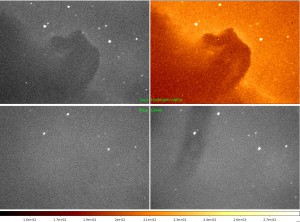While taking the telescope for a shake-down cruise last week, students Pat and Logan obtained these images of the iconic Horsehead Nebula in Orion. Dark clouds of dust are silhouetted against a glowing background of hydrogen gas.

Main item on the night’s list of activities was learning how to create a multi-star pointing model for the telescope. The scope slews automatically to a series of locations in the sky, and at each one, an image is taken with the CCD camera, the stars in the image are automatically identified by software (practically by magic to someone who remembers doing this by hand not so long ago!), and the exact pointing of the scope is computed.
After 20 or so positions in the sky have been mapped in this way the software computes the pointing model. This is a big matrix that maps the telescope mounts drive motors and encoders onto the celestial sphere. It takes care of flexure in the mount, discrepancies in the motor drives, gears, and a host of other factors.
End result? – we commanded the scope to find the Horsehead Nebula, took a long exposure in the Red filter, and there is was!
If you look at the 4 panels in the image, you’ll notice the at the Horsehead is only visible in certain wavelengths of light, and only with very long exposure times. So being able to point and track is essential

